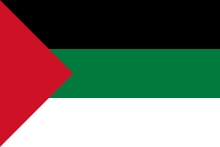This is an old revision of this page, as edited by Koavf (talk | contribs) at 21:27, 4 May 2008 (Reverted edits by Mrjahan (talk) to last version by Koavf). The present address (URL) is a permanent link to this revision, which may differ significantly from the current revision.
Revision as of 21:27, 4 May 2008 by Koavf (talk | contribs) (Reverted edits by Mrjahan (talk) to last version by Koavf)(diff) ← Previous revision | Latest revision (diff) | Newer revision → (diff)
The Pan-Arab colors are red, black, white, and green and have their origins in the flag of the Arab Revolt. The first three colors are featured in the flags of Egypt and Yemen; together with green they are also on the flags of Iraq, Jordan, Kuwait, Palestinians, Somaliland, Sudan, Syria, the United Arab Emirates, and Sahrawi Arab Democratic Republic.
It is believed that each color of the 4 Pan-Arab Colors represent a certain Arab Dynasty or era: the Black was the color of the flag of the Islamic prophet Muhammad, while white was taken by the Umayyads to be their Symbol, as a reminder of the Battle of Badr, Green was taken by the Fatimids to symbolize their support to Ali Bin Abi Talib, while red was the flag held by the Khawarij, and then became the symbol of rulers in North Africa and Al-Andalus.
Other Arab countries, while not using all of the Pan-Arab colors, do use some of them in other combinations: Algeria and Lebanon, for example, use green, white and red, and no black.
Current flags with Pan-Arab colors
-
Ahwaz
Ahwaz -

Egypt -

Iraq -

Jordan -

Kuwait -

Palestine -

Somaliland -

Sudan -

Syria -

United Arab Emirates -

Sahrawi Arab Democratic Republic -

Yemen
Former flags with the Pan-Arab colors
-

The Federation of Arab Republics (Egypt (1972–1984), Syria (1972–1980), and Libya (1972–1977)) -

Libya (1951–1969) -

Libya (1969–1972) -

Kingdom of Iraq (1921–1959) -

Iraq (1959–1963) -

Iraq (1963–1991) and Syria (1963–1972) -

Iraq (1991–2004) -

Syria (1932–1958 and 1961–1963) -

United Arab Republic (1958–1961) -

Yemen Arab Republic (1962–1990) -

People's Democratic Republic of Yemen (1945–1990)